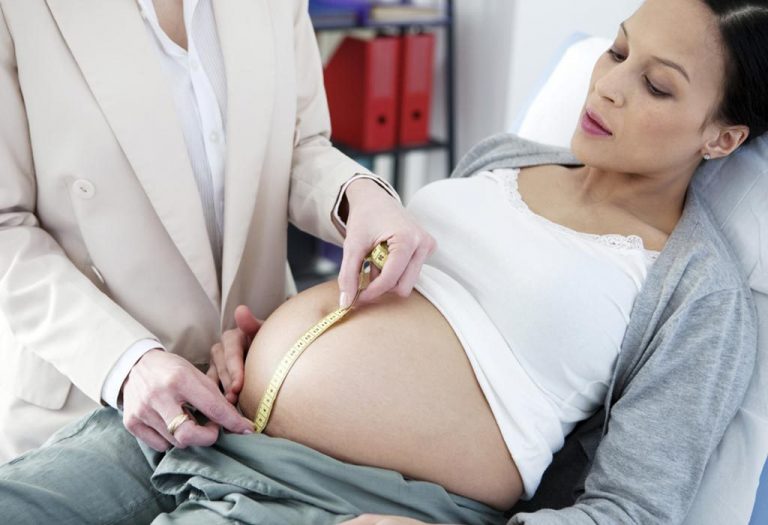Fundal Height in Pregnancy: Measurement & Importance

There are many ways to check if your pregnancy is going according to the norm. Apart from checking your weight, ultrasounds, and your vitals, your doctor might also mention checking the fundal height. This measurement, also referred to as fetal height measurement, is an essential part of prenatal care. It helps determine the baby’s growth and development inside the womb. By measuring the distance from your pubic bone to the top of your uterus, the doctor can assess if your baby’s progress aligns with the expected growth milestones. It is a simple yet effective method to monitor the health of your pregnancy and ensure everything is on track.
What Is Fundal Height?
Fundal height is used to measure the growth and development of the foetus after 20 weeks of pregnancy. It is the measurement from the top of the pubic bone to the top of the uterus. Fundal height in pregnancy is usually measured using a measuring tape. This measurement should match the gestation period within one to three centimetres. The fundal height or McDonald’s Rule will increase as your pregnancy progresses.
Importance of Fundal Height Measurement
If the mother does not showcase any factors for skewed fundal height measurement, then such a measurement could be indicative of the following factors:
- Slow foetal growth
- An abnormally large foetus
- Too little amniotic fluid
- Too much amniotic fluid
However, you must keep in mind that irregular fundal height is not always indicative of any significant issue with your pregnancy.
How to Measure Fundal Height
Fundal height can be measured very easily. Here is a step-by-step procedure for measuring the fundal height.
Step One
It is best that you get the fundal height measurement done by your OB/GYN. This will give you the opportunity to discuss any irregularities in the measurement. So, the first step would be to visit your doctor.
Step Two
Make sure that you empty your bladder entirely before you step into your appointment to have the fundal height measured. Even a half-full bladder can cause a discrepancy in the fundal height measurements, which can lead to unnecessary panic.
Step Three
You will be asked to change into a hospital gown as your regular clothes might influence the fundal height measurement.
Step Four
Your doctor will ask you to lie down as this will allow your doctor to measure the fundal height accurately.
Step Five
Your doctor will ask you to breathe slowly and steadily, which ensures that there is not too much variation in your belly’s size and allows your doctor to gain an accurate reading.
Step Six
Your doctor will now measure the fundal height using a tape measure. The height is measured from the top of the uterus, which will be in your stomach area to the top of the pubic bone, which is in the pelvic region.
Step Seven
You can now change into your normal clothes and discuss the measurement with your doctor.
Step Eight
If there is any discrepancy in the fundal height measurement, then your doctor might ask for a series of investigative tests to find out the cause of the measurement. These tests might include an ultrasound. Your doctor might recommend that you get the tests done immediately or you could make an appointment for a later date.
Fundal Height Chart
Fundal height is a valuable tool used during pregnancy to monitor the baby’s growth and development. The following chart provides a guideline for understanding fundal height measurements and their correlation with pregnancy milestones.
Measuring Fundal Height on Your Own
Measuring fundal height on your own can be a helpful way to track your baby’s growth between doctor visits. While it’s always best to have a professional assessment, you can perform this simple measurement at home with some guidance. Here are a few key points to keep in mind:
- Use a measuring tape: Measure the distance from your pubic bone to the top of your uterus while lying flat on your back.
- Be consistent: Perform the measurement at the same time of day and under similar conditions for accurate tracking.
- Note changes: Record your measurements weekly to observe trends, but consult your doctor if the results deviate significantly from the norm.
What Is the Normal Fundal Height?
Fundal height is measured and recorded on a chart that also contains the normal fundal height range marked on it based on the gestation period. The fundal height chart by week has two variables: the X-axis marks the gestation period in weeks while the Y-axis marks the fundal height. The normal chart has two slopes marked on it to mark the range of normal fundal height. When your doctor measures your fundal height, she will mark the results on this chart. Depending on the location of the fundal height on the chart and the slope it creates when compared to the previous measurement, your doctor will be able to see if the growth of the foetus is regular or not. For example, the fundal height measurement for week 20 of the pregnancy should be between 18 to 22 centimetres. In fact, a rule of thumb that you can follow is that the fundal height should match the number of weeks that you have been pregnant with a couple of centimetres above and below as the normal range.
What Does Measuring Large for Gestational Age Mean?
The reasons for a larger fundal height could include:
- Presence of uterine fibroids
- Loose abdominal muscles probably due to an earlier pregnancy
- Too much amniotic fluid
- You could be carrying multiple foetuses
- You have the wrong due date which will be confirmed by an ultrasound
- Overweight women have a harder time getting an accurate reading
- The foetus is in breach or any other abnormal position
- The pelvis is much narrower than normal
- The baby has macrosomia caused by gestational diabetes
What Does Measuring Small for Gestational Age Mean?
What are the reasons for fundal height measuring small? The reasons for a smaller fundal height could include:
- Your abdominal muscles are well-developed
- Your due date has been calculated incorrectly
- Too little amniotic fluid
- The presence of intrauterine growth restrictions
- You might be underweight
- The baby might have already dropped to your pelvis
When to Consult a Doctor
Fundal height is an important indicator of your baby’s growth during pregnancy, but there are instances when you should seek medical advice to ensure everything is on track. If you notice any of the following, it’s important to consult your doctor:
- Fundal height does not match gestational age: Significant discrepancies in fundal height compared to your pregnancy week may indicate growth issues or complications.
- Sudden or unexpected changes: A rapid increase or decrease in fundal height could be a sign of abnormal fluid levels or other concerns.
- Difficulty identifying the measurement: If you’re unsure about the results or notice irregular patterns, it’s best to have a professional check.
FAQs
1. Can fundal height measurements vary depending on body type?
Yes, body type can influence fundal height measurements. Women with a shorter torso or those who are overweight may have slightly different measurements, as the position and growth of the uterus can be affected by these factors.
2. How accurate are fundal height measurements for predicting a baby’s growth?
While fundal height is a useful tool, it is not 100% accurate. Factors such as the baby’s position, amniotic fluid levels, and individual body differences can affect the measurement. Ultrasounds are often used for a more precise assessment.
3. Is it possible for fundal height to decrease later in pregnancy?
Yes, fundal height may decrease slightly in the final weeks of pregnancy as the baby drops lower into the pelvis in preparation for birth. This is a normal part of the process called lightening and is not typically a cause for concern.
This was all about the measurement of fundal height at 28, 36 and 37 weeks and at other times in the pregnancy. Fundal Height is a tool used to measure the growth and development of the foetus. It is usually a starting point to check for any irregularities which have to be confirmed by other investigative tests. Please consult with your doctor if you think that the fundal height does not fall within the normal range.
References/Resources:
1. Fundal Height; Cleveland Clinic; https://my.clevelandclinic.org/health/diagnostics/22294-fundal-height
2. What is a fundal height measurement? Why does it matter?; Mayo Clinic; https://www.mayoclinic.org/healthy-lifestyle/pregnancy-week-by-week/expert-answers/fundal-height/faq-20057962
3. Haragan. A, Hulsey. T, Hawk. A, Newman. R, Chang. E; Diagnostic accuracy of fundal height and handheld ultrasound-measured abdominal circumference to screen for fetal growth abnormalities (American Journal of Obstetrics & Gynecology); National Library of Medicine; https://pmc.ncbi.nlm.nih.gov/articles/PMC4465094/; March 2015
4. Papageorghiou. A, Ohuma. E, Gravett. M, Hirst. J, et al.; International standards for symphysis-fundal height based on serial measurements from the Fetal Growth Longitudinal Study of the INTERGROWTH-21st Project: prospective cohort study in eight countries; The BMJ; https://www.bmj.com/content/355/bmj.i5662; November 2016
5. Pay. A, Wiik. J, Symphysis-fundus height measurement to predict small-for-gestational-age status at birth: a systematic review; BMC Pregnancy and Childbirth; https://bmcpregnancychildbirth.biomedcentral.com/articles/10.1186/s12884-015-0461-z; February 2015
6. Peter. J, Ho. J, Valliapan. J, Sivasangari. S; Symphysial fundal height (SFH) measurement in pregnancy for detecting abnormal fetal growth (Cochrane Library); National Library of Medicine; https://pmc.ncbi.nlm.nih.gov/articles/PMC6465049/; September 2015
7. Fundal height: Measuring with a tape measure; King Edward Memorial Hospital; https://www.kemh.health.wa.gov.au/~/media/HSPs/NMHS/Hospitals/WNHS/Documents/Clinical-guidelines/Obs-Gyn-Guidelines/Fundal-Height-Measuring-with-a-Tape-Measure.pdf
Also Read:
Baby Growth in Each Trimester
Week by Week Foetal Growth Chart
Signs of a Healthy and Unhealthy Baby in the Womb
Baby Size Week By Week Comparison With Fruits and Veggies
Was This Article Helpful?
Parenting is a huge responsibility, for you as a caregiver, but also for us as a parenting content platform. We understand that and take our responsibility of creating credible content seriously. FirstCry Parenting articles are written and published only after extensive research using factually sound references to deliver quality content that is accurate, validated by experts, and completely reliable. To understand how we go about creating content that is credible, read our editorial policy here.
























